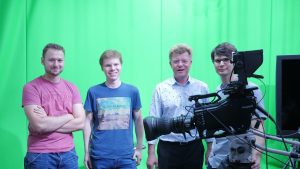Germany’s RheinMain University of Applied Sciences Chooses Ikegami UHK-430 Camera for EVI Project
Story Highlights
RheinMain University of Applied Sciences in Wiesbaden, Germany, recently invested in Ikegami UHK-430 camera technology as the preferred solution for its studies in high dynamic range video imaging. The university’s Enhanced Video Imaging (EVI) project involved the development of an automatic process to detect and brighten dark sections of video while at the same time sensing and enhancing detail in over-exposed sections.
 “One of the main issues involved in progressing from standard dynamic range to high dynamic range television is the need to provide good downward compatibility with the huge number of SDR television receivers already installed and in current use,” says Mike Christmann, Professor of Media Technology at RheinMain University of Applied Sciences.
“One of the main issues involved in progressing from standard dynamic range to high dynamic range television is the need to provide good downward compatibility with the huge number of SDR television receivers already installed and in current use,” says Mike Christmann, Professor of Media Technology at RheinMain University of Applied Sciences.
“The new generation of broadcast cameras can provide a much wider scene contrast range than conventional displays and it is obvious that converters are needed to handle the different formats. A highly dynamic sensor with low noise is key to obtaining the best results from EVI.”
“The more image information we can collect from the camera, the better our system will perform. We chose the Ikegami UHK-430 because it is an excellent-performing 4K UHD HDR broadcast studio camera combined with superb image quality and sensor performance.”
“We are very pleased that the RheinMain University of Applied Sciences chose our technology for this highly successful project,” adds Michael Lätzsch, Broadcast & Professional Video Division Manager at Ikegami Electronics Europe. “EVI has already earned multiple awards and was designated ‘Product Of The Year’ at the NAB 2019 fair in Las Vegas. The UHK-430’s modular design will ensure an easy transition to future transmission standards, supporting ongoing educational and research activity at the highest level for many years to come.”
“Our studies demonstrated beyond question that scene luminance values should not always be reproduced one-to-one on an HDR display”, details Lucien Lenzen who managed the project. “Non-uniform scenes can actually look worse in HDR than in SDR due to the effects of glare. Homogenization techniques, such as using different windows in color grading, can help to compensate for these effects but are not practical when transmitting live. EVI is designed to produce better images on an automated basis in real-time, optimizing lighting balance, and exposure as well as correcting hue and saturation.”
A prototype EVI HDR to SDR downconverter is currently being evaluated by German broadcasters BR and WDR. It runs on a 1U server processing one UHD or two HD streams in real-time. The camera feeds directly to the converter. After conversion, the resulting ‘normal’ SDR signal can be treated in exactly the same way as usual.
The UHK-430 is a 4K-native camera system with simultaneous HDR/SDR processing. Its three 2/3 inch CMOS sensors provide full 3840 x 2160 UHD resolution plus the depth of field needed for studio and outdoor production. The camera is equipped with a B4 bayonet mount compatible with 2/3 inch HD lenses. An optional SE-U430 expander accommodates large studio or OB lenses.
An integrated Ikegami AXII processor enables the UHK-430 to deliver 40 gigabit/s uncompressed full bandwidth video transmission plus a wide range of features including 16-axis color correction and focus-assist for 4K and HD video modes. An optional MoIP module for the UHK-430 allows 4K UHD video plus additional signals such as intercom and return-video feeds to be exchanged between the CCU-430 and a local IP network hub along a lightweight optical fiber instead of requiring multiple SDI cables, enabling easy and low latency signal distribution.
In its standard form, the UHK-430 weighs just 4.6 kg. Dimensions are 149 mm wide x 243 mm high x 340 mm front-to-back.
